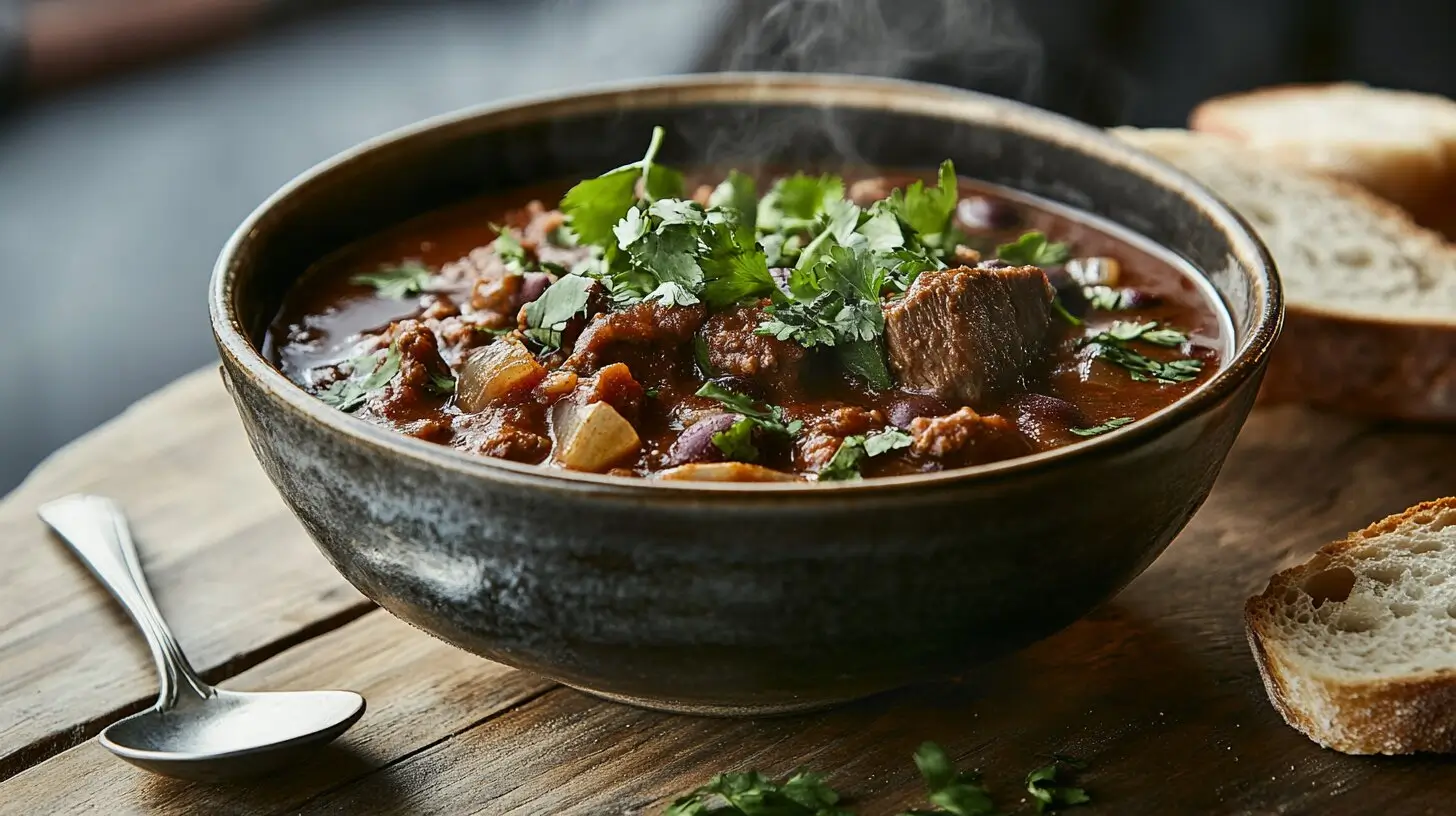Introduction
Deer chili, often made from venison, is a delicious and hearty dish that brings a unique flavor to the table. Whether you’ve cooked up a big batch for meal prep or have leftovers from a family dinner, it’s important to store it properly and know how long it can be safely consumed. For a flavorful way to prepare this dish, check out this Venison Chili Recipe: A Hearty and Flavorful Guide.
In this guide, we’ll explore the shelf life of deer chili when refrigerated, factors that affect its longevity, and how to store it properly. From understanding spoilage signs to tips on extending freshness, we’ve got you covered. Let’s dive in!
Table of contents
Factors Affecting the Shelf Life of Deer Chili
The shelf life of deer chili in the fridge depends on several factors, including its ingredients, preparation methods, and storage conditions. Each of these elements plays a role in determining how long your chili will remain safe and tasty. Let’s break it down:
Ingredients and Their Shelf Life
The combination of ingredients in deer chili can influence how long it stays fresh. For example:
- Venison (Deer Meat): Cooked venison can last about 3–4 days in the fridge when stored properly.
- Vegetables: Ingredients like tomatoes, onions, and peppers are prone to quicker spoilage and can impact the overall shelf life of the dish.
- Spices and Seasonings: While spices themselves don’t spoil quickly, they don’t extend the shelf life of the chili.
Preparation Methods
How you prepare your deer chili is another key factor:
- Cooking Temperature: Properly cooking deer chili to at least 160°F (71°C) ensures that harmful bacteria are killed.
- Cooling Time: Allowing the chili to cool quickly after cooking prevents bacteria growth. Ideally, it should be refrigerated within two hours of cooking.
Storage Conditions
Storing deer chili under the right conditions is essential for preserving its freshness:
- Refrigerator Temperature: The fridge should be set to 40°F (4°C) or below to inhibit bacterial growth.
- Storage Containers: Using airtight containers prevents contamination and locks in flavor.
By considering these factors, you can ensure that your deer chili remains fresh and safe to eat for as long as possible.

Safe Storage Practices for Deer Chili
Proper storage practices are key to ensuring your deer chili stays fresh and safe to eat. By following these tips, you can maximize its shelf life in the fridge and enjoy it for days.
Ideal Fridge Temperature
The temperature of your fridge plays a critical role in preserving the quality of your deer chili.
- Recommended Temperature: Always keep your fridge at or below 40°F (4°C). This prevents bacterial growth, which thrives in warmer environments.
- Use a Thermometer: If you’re unsure about your fridge’s accuracy, a simple thermometer can help you maintain optimal conditions.
Proper Container Selection
The type of container you use for storage can significantly affect the longevity of your chili.
- Airtight Containers: These are the best choice, as they prevent air and bacteria from reaching your chili.
- Glass or BPA-Free Plastic: Glass containers are ideal for odor retention and durability, but high-quality plastic containers work well too.
- Portioning Tip: Divide your chili into smaller portions before storing to make reheating easier and reduce repeated exposure to air.
Refrigeration vs. Freezing
If you’re unsure how soon you’ll eat the chili, knowing when to refrigerate or freeze can make a difference.
- Refrigeration: Best for short-term storage (3–4 days).
- Freezing: For long-term storage, freezing is a better option. Deer chili can last up to 4–6 months in the freezer if stored properly. Ensure you use freezer-safe containers or bags to prevent freezer burn.
By following these safe storage practices, you can enjoy the delicious taste of your deer chili for as long as possible.
Signs Deer Chili Has Gone Bad
Even with proper storage, deer chili won’t last forever. Knowing the signs of spoilage is essential to avoid consuming unsafe food. Here are the most common indicators that your chili has gone bad:
Visual Changes
- Discoloration: Fresh deer chili typically has a rich, vibrant color. If it turns dull, grayish, or develops a green or black hue, it’s likely spoiled.
- Mold Growth: The presence of mold, even in small spots, is a clear sign of spoilage. Always discard chili with visible mold.
Odor and Texture
- Unpleasant Smell: Spoiled chili often emits a sour or rancid odor that’s noticeably off-putting.
- Slimy Texture: If the surface of the chili feels slimy or sticky, it has likely begun to spoil and should not be consumed.
Time Limits for Consumption
- In the Fridge: Deer chili generally remains fresh for 3–4 days when stored properly in the refrigerator. After this period, its safety cannot be guaranteed.
- Frozen Chili: When stored in the freezer, chili can last up to 4–6 months without significant loss of flavor or texture. However, prolonged freezing may result in freezer burn, affecting taste.
What to Do If You’re Unsure
When in doubt, it’s always better to err on the side of caution. If your deer chili shows any of these signs—or if you’re unsure of how long it’s been stored—discard it to avoid potential health risks.
How to Extend the Shelf Life of Deer Chili
If you want your deer chili to stay fresh for as long as possible, there are a few steps you can take to extend its shelf life. These tips focus on proper preparation, storage, and handling practices.
Adding Preservatives
While preservatives are not typically added to homemade deer chili, some natural methods can help keep it fresh longer:
- Vinegar or Citrus Juice: Adding a small amount of acidic ingredients can inhibit bacterial growth.
- Salt: Salt acts as a natural preservative and enhances flavor when used in moderation.
Cooling Before Storing
One of the most important steps in preserving chili is cooling it properly:
- Avoid Hot Storage: Placing hot chili directly in the fridge can raise the internal temperature and encourage bacterial growth.
- Two-Hour Rule: Always allow the chili to cool to room temperature within two hours of cooking. Use shallow containers to speed up the cooling process.
Avoiding Contamination
Handling your chili safely prevents spoilage:
- Use Clean Utensils: Never use dirty spoons or containers when transferring chili for storage.
- Separate Portions: If you plan to reheat chili multiple times, store it in smaller, single-use portions to avoid repeated exposure to air and bacteria.
By following these steps, you can significantly extend the shelf life of your deer chili and reduce food waste.
Health Risks of Consuming Spoiled Deer Chili
Eating spoiled deer chili can pose serious health risks. It’s essential to understand these risks so you can avoid them and keep your meals safe.
Common Foodborne Illnesses
When chili is improperly stored or consumed past its safe period, harmful bacteria can grow, leading to foodborne illnesses. Here are some common risks:
- Salmonella: Often found in undercooked or spoiled meat, salmonella can cause symptoms like diarrhea, fever, and stomach cramps.
- Clostridium Perfringens: This bacterium thrives in food that isn’t cooled or reheated properly and can cause severe stomach pain and diarrhea.
- Listeria: Found in improperly refrigerated food, listeria infections can be especially dangerous for pregnant women, older adults, and those with weakened immune systems.
Prevention and Awareness
Preventing these health risks involves proper handling and storage of your deer chili:
- Avoid the Danger Zone: Keep your chili out of the temperature range between 40°F (4°C) and 140°F (60°C), where bacteria grow most rapidly.
- Reheat Properly: When reheating chili, ensure it reaches an internal temperature of at least 165°F (74°C) to kill any bacteria.
- Trust Your Senses: If the chili smells off or looks unusual, it’s better to throw it away than risk illness.
By understanding these risks and following proper storage and reheating techniques, you can safely enjoy your deer chili without worry.

Frequently Asked Questions
To address common concerns about storing and handling deer chili, here are detailed answers to frequently asked questions:
Can You Reheat Deer Chili More Than Once?
Yes, you can reheat deer chili more than once, but it’s not ideal. Every time you reheat and cool the chili, the risk of bacterial growth increases. To minimize this risk:
- Reheat only the portion you plan to eat.
- Ensure the chili reaches an internal temperature of 165°F (74°C) before consuming.
How Long Does Frozen Deer Chili Last?
Frozen deer chili can last up to 4–6 months without significant loss of quality. For the best results:
- Store it in airtight, freezer-safe containers or heavy-duty freezer bags.
- Label containers with the date of freezing to keep track.
Can Spices Extend the Shelf Life of Chili?
While spices add flavor, they do not significantly extend the shelf life of chili. However, some ingredients like garlic and chili peppers may have mild antibacterial properties. Still, proper storage practices are the most effective way to preserve chili.
What to Do If You Accidentally Left Deer Chili Out Overnight?
If deer chili has been left out at room temperature for more than 2 hours, it’s no longer safe to eat. Bacteria grow rapidly in this “danger zone,” and reheating it will not make it safe. It’s best to discard it.
Is It Safe to Store Chili in a Metal Pot in the Fridge?
Yes, it’s safe to store chili in a stainless steel or non-reactive metal pot in the fridge, as long as the pot has a tight-fitting lid. However, transferring it to an airtight container is recommended to preserve flavor and prevent odor absorption.
Can Adding Acidic Ingredients Help Preserve Chili?
Yes, acidic ingredients like tomatoes, vinegar, or lime juice can slow bacterial growth to some extent. However, they should not replace proper refrigeration.
Conclusion
Storing deer chili safely is key to enjoying this flavorful dish without compromising on taste or health. In the fridge, deer chili typically lasts 3–4 days, while freezing extends its shelf life to 4–6 months. Factors such as ingredients, preparation methods, and storage conditions all influence its longevity. By following safe storage practices and being vigilant about spoilage signs, you can enjoy every bowl of deer chili with confidence.
Whether you’re meal prepping or saving leftovers, the tips in this guide will help you maximize freshness while keeping foodborne illnesses at bay.

